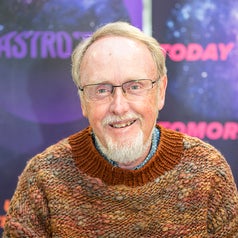New Type of Stellar Explosion Could Explain the Mystery of the Milky Way’s Elements

Share
Until recently it was thought neutron star mergers were the only way heavy elements (heavier than zinc) could be produced. These mergers involve the mashup of the remnants of two massive stars in a binary system.
But we know heavy elements were first produced not long after the Big Bang, when the universe was really young. Back then, not enough time had passed for neutron star mergers to have even occurred. Thus, another source was needed to explain the presence of early heavy elements in the Milky Way.
The discovery of an ancient star SMSS J2003-1142 in the Milky Way’s halo—which is the roughly spherical region that surrounds the galaxy—is providing the first evidence for another source for heavy elements, including uranium and possibly gold.
In our research published yesterday in Nature, we show the heavy elements detected in SMSS J2003-1142 were likely produced, not by a neutron star merger, but through the collapse and explosion of a rapidly spinning star with a strong magnetic field and a mass about 25 times that of the sun.
We call this explosion event a “magnetorotational hypernova.”
Stellar Alchemy
It was recently confirmed that neutron star mergers are indeed one source of the heavy elements in our galaxy. As the name suggests, this is when two neutron stars in a binary system merge together in an energetic event called a “kilonova.” This process produces heavy elements.
However, existing models of the chemical evolution of our galaxy indicate that neutron star mergers alone could not have produced the specific patterns of elements we see in multiple ancient stars, including SMSS J2003-1142.
A Relic From the Early Universe
SMSS J2003-1142 was first observed in 2016 from Australia, and then again in September 2019 using a telescope at the European Southern Observatory in Chile.
From these observations, we studied the star’s chemical composition. Our analysis revealed an iron content roughly 3,000 times lower than the sun’s. In other words, SMSS J2003-1142 is chemically primitive.
The elements we observed in it were likely produced by a single parent star, just after the Big Bang.
Signatures of a Collapsed Rapidly Spinning Star
The chemical composition of SMSS J2003-1142 can reveal the nature and properties of its parent star. Particularly important are its unusually high amounts of nitrogen, zinc, and heavy elements including europium and uranium.
Be Part of the Future
Sign up to receive top stories about groundbreaking technologies and visionary thinkers from SingularityHub.


The high nitrogen levels in SMSS J2003-1142 indicate the parent star had rapid rotation, while high zinc levels indicate the energy of the explosion was about ten times that of a “normal” supernova—which means it would have been a hypernova. Also, large amounts of uranium would have required the presence of lots of neutrons.
The heavy elements we can observe in SMSS J2003-1142 today are all evidence that this star was produced as a result of an early magnetorotational hypernova explosion.
And our work has therefore provided the first evidence that magnetorotational hypernova events are a source of heavy elements in our galaxy (alongside neutron star mergers).
What About Neutron Star Mergers?
But how do we know it wasn’t just neutron star mergers that led to the particular elements we find in SMSS J2003-1142? There’s a few reasons for this.
In our hypothesis, a single parent star would have made all the elements observed in SMSS J2003-1142. On the other hand, it would have taken much, much longer for the same elements to have been made only through neutron star mergers. But this time wouldn’t have even existed this early in the galaxy’s formation when these elements were made.
Also, neutron star mergers make only heavy elements, so additional sources such as regular supernova would had to have occurred to explain other heavy elements, such as calcium, observed in SMSS J2003-1142. This scenario, while possible, is more complicated and therefore less likely.
The magnetorotational hypernovae model not only provides a better fit to the data, it can also explain the composition of SMSS J2003-1142 through a single event. It could be neutron star mergers, together with magnetorotational supernovae, could in unison explain how all the heavy elements in the Milky Way were created.
This article is republished from The Conversation under a Creative Commons license. Read the original article.
Image Credit: NASA/JPL-Caltech/ESA/CXC/STScI, Public domain, via Wikimedia Commons
My current position is that of Emeritus Professor of Astronomy at the Research School of Astronomy and Astrophysics at the Australian National University. Prior to joining the ANU in 1995 I held positions at the Anglo-Australian Observatory and at Yale University. My research interests include the stellar populations of dwarf galaxies, the origin of abundance anomalies in globular cluster stars, the Magellanic Clouds, and the formation of the halo of the Milky Way. I am the convenor of the research group that is using photometry from the ANU SkyMapper telescope to search for extremely metal-poor stars in the halo of the Milky Way galaxy. I served as RSAA Associate Director (Academic) from 2004 to 2007 and was RSAA Interim Director for 4 months in 2007. Until March 2018 when I moved to Emeritus status I served as the RSAA PhD program convenor for the previous six years. I have also been Vice-President (2003-2005), President (2005-2007) and Immediate Past President (2007-2009) of the Astronomical Society of Australia (ASA). In July 2018 I was made an Honorary Fellow of the ASA ''in recognition of distinguished contributions to Astronomical Research and service to the Australian Astronomical Community''.
Related Articles

Data Centers in Space: Will 2027 Really Be the Year AI Goes to Orbit?

Scientists Say We Need a Circular Space Economy to Avoid Trashing Orbit

New Images Reveal the Milky Way’s Stunning Galactic Plane in More Detail Than Ever Before
What we’re reading
